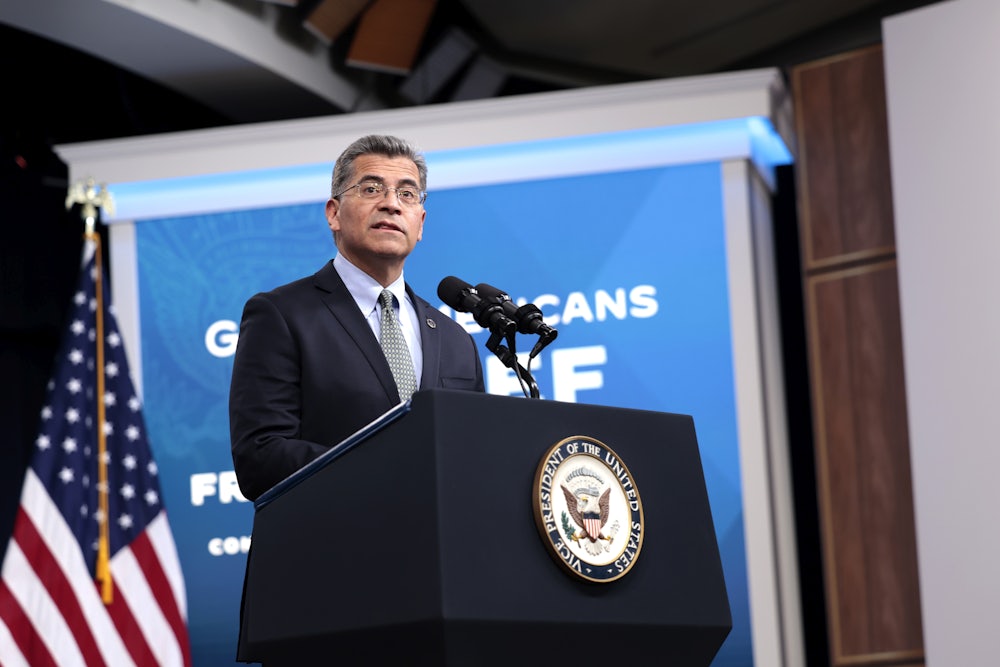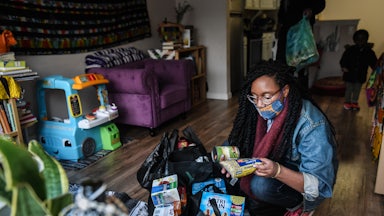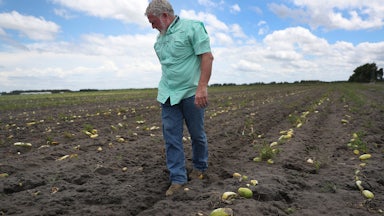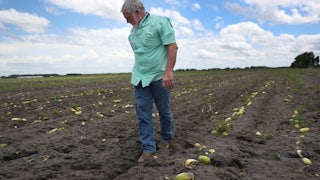Earlier this month, with little fanfare, Secretary of Health and Human Services Xavier Becerra renewed the public health emergency declaration regarding the coronavirus pandemic. Society at large may be returning to a sense of normalcy, but at least for the next 90 days, the Biden administration has deemed the situation worthy of such a declaration.
The federal government met the onset of the pandemic by strengthening the American social safety net, implementing temporary measures such as providing additional unemployment insurance, establishing a moratorium on evictions, expanding free school lunch programs for students, instituting continuous Medicaid enrollment, and expanding nutrition programs utilized by millions of low-income Americans. As time went on, however, many of these benefits expired or were struck down in courts or permitted to elapse by Congress.
Congress passed legislation in 2020 that ties certain flexibilities in the nation’s nutritional programs to the public health emergency. However, when the Biden administration determines that the declaration is no longer warranted, those flexibilities will expire, leaving millions of Americans to fall down a steep cliff in benefits even as inflation soars.
One such program is emergency allotments for the Supplemental Nutrition Assistance Program, which provides eligible households with at least an additional $95 per month. With the emergency allotments, many participants who would normally receive less than the maximum amount could then receive hundreds of dollars more, until they reached the maximum benefit. (More than 41 million Americans are SNAP recipients.) The allotments are tied to the federal public health emergency, meaning that the majority of SNAP households will see a dramatic cut in their benefits when the declaration ends. The Food Research and Action Center, or FRAC, estimates that SNAP recipients will lose, on average, $82 per month at that time. For one person receiving the minimum SNAP benefit, the monthly allotment will drop from $250 to $20 per month.
The Department of Health and Human Services has committed to issuing a 60-day advance notice for the end of the public health emergency. A spokesperson for the Department of Agriculture told The New Republic that the agency is working with states and local program operators to prepare for that eventuality and engaging with key stakeholders and advocacy groups.
“As our country moves forward into a new phase of building back better from the pandemic and the public health emergency expires, certain flexibilities will also come to an end,” a USDA spokesperson told The New Republic. “However, USDA’s work is not done. Moving forward, USDA will continue to work with our partners to further improve nutrition security for all Americans by removing barriers to access across all its programs, incorporating lessons learned from the pandemic to the greatest extent possible.”
When the emergency ends, states will have one month to transition recipients off of their allotments. But nearly a dozen Republican-led states have already cut the allotments by ending their own emergency declarations or choosing not to extend the benefit, leaving millions of people with dramatically slashed benefits.
States that have ended or will soon end their emergencies no longer receive the allotments. They can, however, request an additional month of allotments before ending them. Because their state public health emergencies ended in March, benefits will be cut next month in Wyoming, Kentucky, Arizona, Indiana, Virginia and perhaps other states. As of this week, only eight states had received approval to have their emergency allotments extended through May. The public health emergencies were set to expire in several more states in April, meaning that those states could have one more month of emergency allotments in May before they are cut in June.
This looming “hunger cliff” for millions of Americans comes as inflation approaches historic highs, with food costs in particular rising dramatically. Maximum SNAP allotments are updated each year based on the Thrifty Food Plan, which is indexed in June and takes effect in the next fiscal year. This means that SNAP recipients are receiving benefits based on the cost of food in June 2021, even though inflation has since jumped significantly.
/ In honor of Earth Day, TNR’s climate coverage is free to registered users until April 29. Start reading now.
“The SNAP households, they’re the ones who are going to have to figure out how they’re going to cope, when they’ve probably already been coping with quite a bit. And where the cushion is going to come from to make up that amount of a loss is very hard to say,” said Ellen Vollinger, the SNAP director for FRAC. The expanded child tax credit, which provided families with up to $350 per month for children under 6 and $300 per month for children between ages 6 and 17, is one such program that could have provided such a cushion, but it expired at the end of last year.
The people who will be affected the most by the loss of the allotments are those receiving lower SNAP benefits. Although these recipients have higher incomes than those receiving the maximum benefits, they still have very low income; household income must be at or below 130 percent of the poverty line, or about $28,550 for a family of three. Diane Whitmore Schanzenbach, the director of the Institute for Public Research at Northwestern University, said that the people who receive lower SNAP benefits tend to be elderly or low-income families with children.
“We’re all feeling inflation, and low-income families feel it all the more acutely, because there’s less slack in their budgets. And so, whereas for some families the increased price of groceries might mean ‘Well, we’re not going to take a long vacation’ or ‘We’re not going to go out to the movies,’ for lower-income families, the choices can be really between necessities and necessities,” Schanzenbach said.
Survey data from Propel, creators of an app called Providers that helps SNAP users manage their benefits, shows worrying trends for recipients living in states that have discontinued emergency allotments. An April survey of a random sample of five million Providers users showed that 26 percent skipped meals in states with emergency allotments, compared with 31 percent in states without, according to data shared with The New Republic. In states with emergency allotments, 20 percent reported visiting a food pantry, compared with 25 percent in states without the allotments. High costs are also a problem: 56 percent of users spent more than $100 on food beyond their benefits in states with the emergency allotments, and nearly 64 percent in states without.
Even before the spike in food prices, SNAP benefits were not fully sufficient for many recipients. A November report by the Urban Institute noted that, even though the Agriculture Department increased the maximum SNAP benefit by 21 percent last year, the allotment fell short of meal costs in 1 in 5 counties. But that data was based on 2020 food prices, so the stress felt by families is likely even higher now.
“While we would expect at some point these emergency provisions to be rolled back … the reality is, we’re really not out of the woods,” said Elaine Waxman, a senior fellow at the Urban Institute’s Income and Benefits Policy Center. “The number of households that have been using SNAP has come down a little bit, which is what we would expect as the recovery proceeds. But you don’t dig out of these kinds of economic shocks right away, as much as we would all like.”
The cutting of these benefits will likely put stress on the charitable sector, with SNAP recipients perhaps having to turn to already overwhelmed food banks that are also struggling with higher costs. Feeding America, which represents 200 food banks, reported this month that such organizations are buying nearly as much food as they did in 2021 but spending 40 percent more for those purchases. And despite the easing of pandemic-related measures, the demand for food assistance remains high.
There’s an argument to be made that people with higher incomes should not be receiving the maximum SNAP benefit, compared with those with no income at all. The emergency measures were intended to be temporary. But although the Biden administration raised SNAP benefits last year, the impact of higher prices could offset those increases, which would then be compounded by the steep loss in emergency allotments. “It was a policy choice to make it a cliff instead of a ramp,” Schanzenbach said.
Emergency allotments are not the only measures that will expire with the end of the federal public health emergency declaration. A temporary expansion of SNAP eligibility for college students will expire 30 days after the public health emergency is lifted. Administrative flexibilities making it easier to participate and remain enrolled in SNAP—such as suspending the three-month time limit for able-bodied adults without dependents to receive SNAP unless they work and allowing states to waive in-person interviews for households—will likely not be extended after the public health emergency ends.
“When the declaration goes away, that will come back in force, the interviews and some of the things that are procedural hurdles for people to be able to qualify. Even though they meet the eligibility criteria, just getting through that process can be difficult for people,” Vollinger said.
Some waivers making it easier to receive the Special Supplemental Nutrition Program for Women, Infants, and Children, or WIC, will also expire with the public health emergency. In 2020, Congress gave the USDA authority to grant waivers allowing participants to receive their benefits remotely and permitting them to enroll and re-enroll in WIC without visiting a clinic in person. Although USDA authority to grant new waivers ended in September of last year, these waivers will be in place until 30 days after the end of the public health emergency.
Waxman related the story of a single mom she had interviewed for her research: The mother, who works full-time, had previously struggled to get to appointments but is now able to communicate over the phone with the WIC office during her lunch break.
“It enabled her to actually stay more engaged in the parts of WIC that people really prize, like nutrition and educational support, as well as just maintaining her enrollment, but was more realistic about her life as a working mom,” Waxman said. “I think when we learn these things, those are innovations worth preserving.”
Multiple waivers related to child nutrition, tied not to the public health emergency but to the school year, are also set to expire at the end of June. With the expiration of flexibilities pertaining to SNAP and WIC—either on a state level in the immediate term or federal level in the near future—Americans who rely on nutrition programs to feed themselves and their families will be facing more instability in the ensuing weeks and months. The end of state and federal public health emergencies may be seen as a reason to celebrate but will also have significant costly consequences.
“It’s going to come as a huge shock when this happens. I think a lot of the public just has no idea,” Vollinger said.










